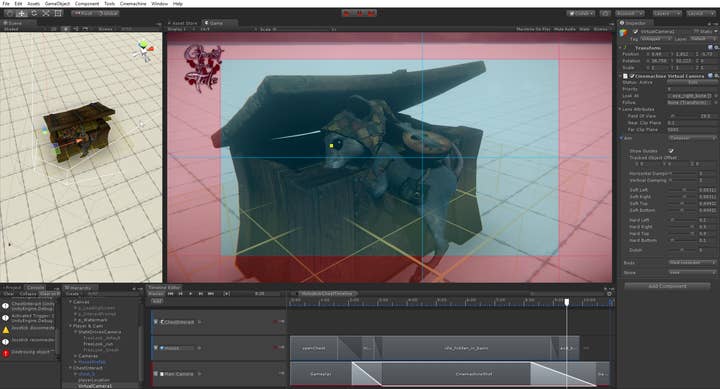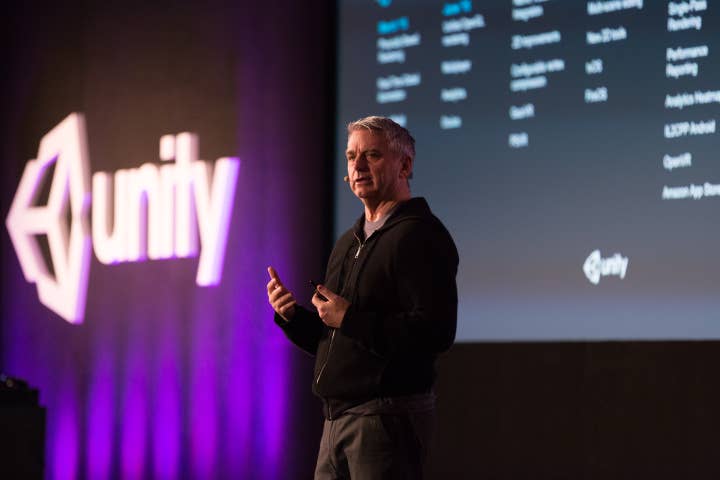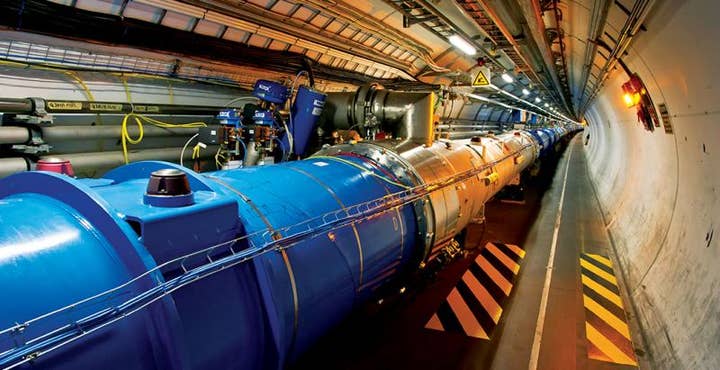Riccitiello: “There's always blood and sweat. We'd like to make the tears go away”
The Unity CEO discusses the firm's next step to solving all of the world's (games development) problems
John Riccitiello opened his company's GDC 2017 keynote in much the same style he has every major Unity presentation over the past few years: reiterating the company's three goals, one of which is solving hard problems.
Until now, this has predominantly focused on the problems faced by coders, programmers and anyone else that has to deal with what he calls the "nitty gritty" of games development. But this year, Riccitiello announced the company would start to concentrate on members of the creative process that Unity has perhaps overlooked in the past: artists and designers.
The presentation was just the start of this. The firm opened a competition to win the newly-created role of artist-in-residence at Unity, while Natalya Tatarchuk, the engine firm's new graphics director and Bungie's former graphics lead on Destiny, discussed the visual upgrades that Unity has planned.
Speaking to GamesIndustry.biz in San Francisco, the Unity CEO explained that this added focus on the visual aspect of games development is just the next natural step in the company's evolution.

"Our business planning process starts by asking what the greatest pain for developers is and how we can help them the most," Riccitiello tells us. "When we started Analytics, we didn't have any idea what we were going to do with it, we just knew developers needed it - and now we've turned that into an effective augmentation of our ad business and it's growing really quickly, so it turned out to be a smart thing from a business perspective. We offer Collaborate [a cloud-hosted service that enables devs to share and sync their Unity project], we don't make any money off of it, we just figure out how to invest in it. And that's maybe less wise - just don't tell my Board.
"I've run studios directly as a general manager at EA for a long time, and I've seen artists work really hard creating a scene or animation. They give it to the programmer who puts it in the game but then says the level of detail has to be cut by half because it's bringing the framerate down. It puts both the programmer and the artist in an awkward position, and it's a pretty sucky process - particularly if you're an artist. You might sometimes feel like the technology choices are the lowest common denominator, where your creativity is curtailed. We think we can solve that.
"The whole industry has grown up around this constraint, but it doesn't have to be that way"
"We think we can essentially put the artists and designers on a level playing field with the programmers so they can work in a collaborative way with the same tools. We talked about visual scripting, and that can be just as powerful, just as leveraging as programming when done well. So artists, designers and programmers can be partners. This is simply us attacking a fundamental problem that I think gets in the way of creativity. Any great programmer or technologist realises they're often in this position of being a gating item or a block to the creativity of the artist - and that sort of sucks. That's not a good place to be. The whole industry has grown up around that constraint, but it doesn't have to be that way."
Building tools that satisfy the needs of studios' coding, art and design departments is also an extension of the impact Riccitiello has had on Unity as a company. Recalling his early days at the engine provider, the CEO says his first priority was to "staff up aggressively" on technical talent - more recently, this has expanded to include art and technical art talent. Bringing in experienced people such as Tatarchuk, people who have experienced first-hand what developers need to accomplish their visions, enables Unity to better tailor its engine to the changing standards of games today.

Riccitiello estimates his company has the equivalent talent to "two significant production teams" but distributed across the organisation rather than making games. This latter point is crucial to the exec: while he's happy for the team to produce tech demos such as short film Adam, he intends to maintain a strict line between tools and games development.
"I believe you can't be good at everything," he says. "People that make great games are often not very good at making great tools, and vice versa. If Unity were building an FPS... if you [as a developer] were making an FPS yourself, you're going to wonder what advantage in the core tech our product has over another. Over the years when I was on the content side, I worried about that.
"We wanted to be like a large-scale game production studio that doesn't have to ship games"
"We wanted to be as if we were a large-scale game production studio where we don't compete with our customers and we don't have to ship games. We want to ship things that make games developers more successful."
His comments allude to his principal competitors: Epic Games and its Unreal Engine, Crytek and CryEngine, and Amazon's Lumberyard. All three firms focus primarily on the production of tools for other developers, but still continue to produce their own titles as showcases for their tech.

Competition in the engine space has heated up over the past few years, particularly with the introduction of Lumberyard and both Epic and Crytek adopting a free or pay-what-you-want model. And yet Riccitiello is comfortable with Unity's position in the market. During the presentation, he may have focused on Unity's dominance on mobile - powering 38% of the Top 1000 games on iOS and Android - but he maintains his company is a force to be reckoned with on any platform.
"Our share is higher on console - we just don't talk about it as much," he says. "It's not a very big market for development by comparison to mobile. Our market share is comparable, if not a little higher. It's higher in VR as well: 59% to 71%, depending on the platform. So we're big there, too - it's just not as many developers in comparison to mobile. Mobile is legions compared to console and the number of developers in that space. I don't think there is much competition for us in mobile. There is some for us in console - our principal competitor [is mainly used in] 20 or so high-profile projects, so the actual market share for us is much larger."
Riccitiello went on say that he actually relishes having such powerful competitors out there to contend with: "They're damn good engineers and they do some really good things. Sometimes we learn from watching what they do, and sometimes they learn from watching what we do. Realistically, the current version of Unreal is a pretty good copy of Unity. Of course, I'm not saying they're actually copying us, not at all. I think Tim Sweeney is awesome. What I mean is their product wasn't set up for ease of use in mobile, but now they're a lot closer."
He reiterates that Unity's market share is very high "on almost any platform you can think of", and stresses that thanks to services like Unity Analytics and Unity Ads, he believes the business is "not really a game engine company exclusively".
"We spend as much time and energy on helping developers solve other hard problems that aren't just related to content creation, like making money - and none of our competitors compete with us there"
He elaborates: "We're a developer company. We spend as much time and energy on helping developers solve other hard problems that aren't just related to content creation, like making money - and none of our competitors compete with us there"
Unity's presentation at GDC was a stark contrast to that of Unreal. While Riccitiello and his team focused solely on games development and new features that will help these customers, Unreal once again rolled out a string of high-profile partnership with the likes of Andy Serkis, LucasFilm and Chevrolet. When asked if Unity has any plans to expand its efforts outside the realm of video games, Riccitiello remarks that it already has.
"We tend not to talk about it a lot, but Jet Propulsion Lab uses us for the Mars Rover and CERN uses us for the Large Hadron Collider," he says. "Almost anyone that uses VR for architecture uses us. The gambling industry is pretty much centred on using Unity.
"My view is that until we were perfect at nailing the gaming, AR and VR business, I was going to keep our concentration on that so we didn't dilute our efforts. But there is a huge number of folks that use our product outside of the games industry - we just try to keep our focus tight."

Unity's games business has undergone a series of changes over the past year, not the least of which was splitting its userbase into three subscription tiers: Personal, Pro and Plus. The introduction of the latter caused some grumbling from long-running Unity developers, concerned that the tech was becoming too expensive after Unity removed the pay-to-own option and focused on a yearly fee. But the firm was quick to tweak its offering in order to address some of these issues. Nonetheless, some devs remain disgruntled, particularly given how cheap rival technology is. Is Riccitiello still facing heat for these changes?
"I wouldn't say that subscription is one gigantic bonfire party where they all ran into our camp, but they didn't all leave either and we continue to grow"
"No single customer has complained to me, and our usage numbers are up dramatically," he says. "The number of downloads is up, the number of customers is up. I wouldn't say that subscription is one gigantic bonfire party where they all ran into our camp, but they didn't all leave either and we continue to grow.
"There was a little noise when we first did it, so we made some adjustments to make sure we're listening to our customers. We trip, sometimes more often than other companies, but we fix it quickly. There were a couple of wrinkles with subscriptions, but now everyone seems to like it. And it's a more logical way to pay for something that's changing every quarter."
Quarterly updates is perhaps the biggest change Unity is now going through. With version 5.6 of its engine released at the end of March, the firm has brought the Unity 5 cycle to a close and is now gearing up for the first release of Unity 2017. It's not confirmed whether the year tag will be updated every 12 months - i.e. Unity 2018, Unity 2019, and so on - but the implication is there. Previously, Unity life cycles would span multiple years. Is Riccitiello and his team now under pressure to deliver a significant overhaul every year in order to make the new version seem more valuable?
"We deliver more in Unity 5.6 than we did in the entire cycle of Unity 4," he says. "The point I'm making is there's no way to measure. For a very long time, Unity had a relatively small development operation - less than 100 developers focusing on producing our core tech. We're now many, many times larger than that, we're producing so much more content. Each quarterly release is a major upgrade.
"This gives us permission to avoid a couple of stupid things, like holding something back to put in the next big edition because you're trying to sell something. Now if something's ready, we put it out immediately. Part of the reason we do that is we support so many platforms. Back on Unity 3, we supported four platforms - now it's more than 30. Apple has Metal on MacOS so are we going to ask developers to wait for Unity 6 before we support that? No, we'll put it in next quarter."

Even so, does incremental updates every quarter not limit Unity's ability to signify the biggest overhauls? The launch of Unity 5 was a call to action for many devs as it was instantly recognisable as a momentous advancement over Unity 4.
"We're not having any problems selling it," Riccitiello says. "Can you think of a developer that doesn't use it? We're not having trouble getting new users."
He goes on to add that the key new features in each quarterly update will serve as selling points for new and sometimes more specific customers. Unity 5.6's cinematics tool Timeline, the scriptable rendering pipeline on course for Unity 2017, and even the C# jobs system discussed at the presentation will be a "big deal" to someone in the Unity-trained community.
There is also the chance for developers to contribute to future updates. Plenty of developers customise and build on Unity's tech, and Riccitiello says the firm is always keen to work with such studios to integrate their improvements into the engine. The most notable example of this is the competition for Unity devs to create new features for its VREditor, which allows users to create levels and environments from within virtual reality itself. It could be argued that Unity is simply calling on the community to fix its tool on its behalf, but Riccitiello says this isn't the case.
"The vast majority of what's in Unity is built by Unity," he says. "We've been partnering with people for a decade now, and on occasion they'll do a source view with us, they'll make an improvement and we'll import that improvement into the core. We're not so arrogant to suggest that every idea has to be ours."
